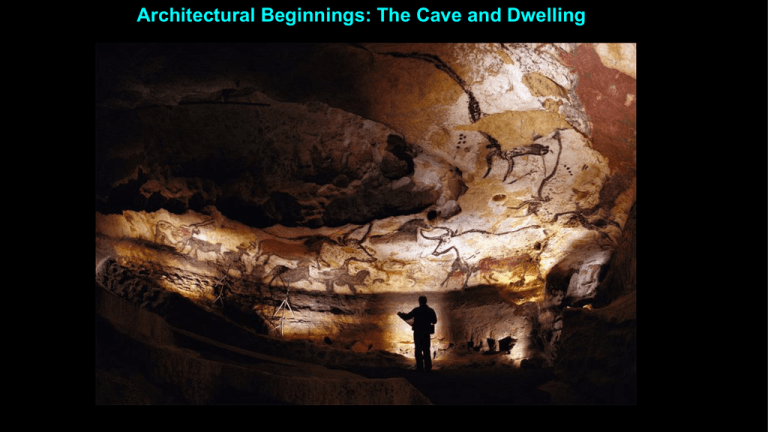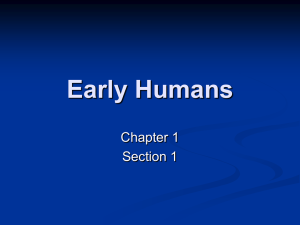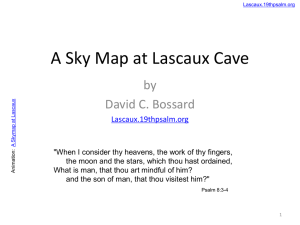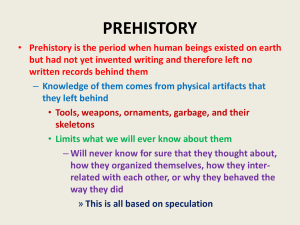Lect. 1 _8/22/11
advertisement

Architectural Beginnings: The Cave and Dwelling I. Paleolithic Dwellings Terra Amata dwellings, Terra Amata, France, c. 400,000 B.C. Lecture Outline Exam Who? Paleolithic architect (s) the intended audience the incidental audience What? Dwelling Where? Terra Amata, France When? 400,000 B.C. or B.C.E. Paleolithic How ? How did it come to look this way? Why? Why did it look this way in this place and at this time? Terra Amata huts I. A. Historical context - Independent factual knowledge of historical conditions at this time and place Olduvai Gorge, Tanzania – earliest evidence of man-made habit in 2,000,000 BC Lower Paleolithic (2,500,000-300,000 BC): • transition from scavenging to hunting-gathering • nomadic, small groups of ½ dozen families • first evidence of craft and stone tools • first evidence of control of fire after 400,000 BC • possible symbolic vocalizations after 400,000 BC I. B. Formal Analysis: Describe the material, scale, and shape Terra Amata dwelling I. C. Meaning Social and ritual values shaping the arch. of the Paleolithic dwelling 1. Why were the Paleolithic Terra Amata huts about the same size? Terra Amata dwellings I. C. 2. Why did these Paleolithic dwellings have an oval form? Terra Amata dwelling Preparing review materials ONLINE STUDY IMAGES http://www.uark.edu/~archmed/ user name: arch2233 password: peristyle Preparing review materials II. Paleolithic sacred space Lascaux Cave, Lascaux, France, c. 10,000 B.C. Hall of the Bulls Axial Gallery Who? Paleolithic architect (s) the intended audience the incidental audience What? Lascaux Cave Sacred space Where? Lascaux, France When? 10,000 B.C. or B.C.E. How ? How did it come to look this way? Why? Why did it look this way in this place and at this time? Lascaux Cave II. A. Context Upper Paleolithic (40,000-10,000 BC): • last glaciers of the ice age melt • big game hunters and gatherers • nomadic groups of ½ dozen families, leadership informal • material possessions evenly distributed • earliest identifiable religious and burial sites • proficiency in visual arts II. B. Formal analysis of structural environmental qualities 1. Describe the entrance and ground plan as you would experience them Lascaux Cave Hall of the Bulls II. B. 2. Describe the interior surfaces as you would experience it Lascaux Cave Hall of the Bulls Axial Gallery Axial Gallery far end II. B. 3. Describe the subjects of the painting and your experience of them Lascaux Cave The Shaft Hall of the Bulls Axial Gallery II. C. Why was this a suitable form – ideal sacred space – for this place and time (i.e., the Paleolithic era)? Lascaux Cave The Nave Hall of the Bulls II. C. 1. It showed respect for nature’s difficulties. What is the physical evidence for this? Lascaux Cave Hall of the Bulls Entry II. C. 2. It embodied perpetual change and perpetual interflow of time (an eternal present): What is the physical evidence for this? Lascaux Cave Axial Gallery Axial Gallery II. C. 2. Lascaux Cave Hall of the Bulls The Nave Hall of the Bulls II. D. C. 3. What It acknowledged is Kostof’s ritual-based impenetrable explanation mysteriesfor ofthe life.selection What is of thea physical cave as aevidence sacred space? for this? Lascaux Cave Paleolithic female statuette Axial Gallery Venus of Willendorf, 30,000 B.C. Hall of the Bulls Organizing for course material for review Paleolithic sacred space a. b. c. d. eternal present respect for nature concern with mysteries of life reasons why these were Paleolithic concerns











